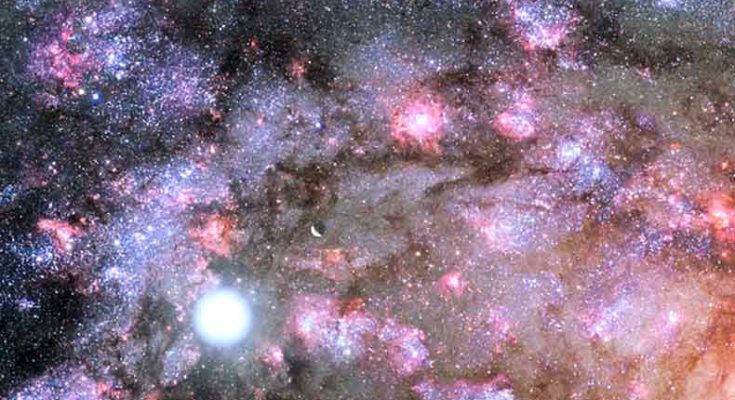NASA Telescopes Reveals a Giant Galaxy. Image Courtesy – NASA, Z. Levay, G. Bacon (STScI).
An unusual structure, around 100,000 light-years long, which is similar to a corkscrew-shaped string of pearls and winds around the cores of two colliding galaxies was revealed by NASA’s Hubble Space Telescope. This structure is named “Sparky” by NASA.
The unusual structure of the star spiral may create new insights into the formation of stellar superclusters that result from merging galaxies and gas dynamics and blazing, blue-white, newly born stars in this rarely seen process.
Grant Tremblay of the European Southern Observatory said, “We were surprised to find this stunning morphology. We’ve long known that the ‘beads on a string’ phenomenon are seen in the arms of spiral galaxies and in tidal bridges between interacting galaxies. However, this particular supercluster arrangement has never been seen before in giant merging elliptical galaxies”.
Read: Possibility of slow-down in Climate Change rate for the Next Decade
Young, blue super star clusters are spaced inhomogeneous intervals along the chain through the galaxies at separations of 3,000 light-years. The pair of elliptical galaxies is inserted inside the dense galaxy cluster. The cluster’s powerful gravity twisted out the images of background galaxies into blue streaks and curvature which is formed displaying an illusion of being inside the cluster. This phenomenon is known as gravitational lensing.
The underlying physical processes that give rise to the “string of pearls” structure are related to the Jeans instability, a physics phenomenon that occurs when the internal pressure of an interstellar gas cloud is not strong enough to prevent the gravitational collapse of a region filled with matter, resulting in star formation. This process is analogous to that which causes a column of water falling from a rain cloud to disrupt, and rain to fall in drops rather than in continuous streams.
The physical processes which created this “String of Pearls” structure are related to a physics phenomenon called “Jeans Instability”. It happens when an internal pressure of an interstellar gas cloud is weak to combat the gravitational collapse of an area filled with matter. So the star formation is created. This process is comparable to a particular situation that generates water column disruption from a rain cloud, and rainfall in drops instead of falling continuously.
Read: Level of Carbon Dioxide in 2013 has overflowed than previous 30 years
Scientists are observing currently in detail the star chain’s origin. Cold molecular gas is the catalyst of the burst of star formation that may have been native to the two merging galaxies, this is one probable possibility. Another possibility is a so-called “cooling flow” scenario, where gas cools from the ultra-hot atmosphere of plasma that surrounds the galaxies, forming pools of cold molecular gas that starts to form stars. The third possibility is that the cold gas fueling the chain of star formation originates from a high-temperature shock wave, which originated when the two giant elliptical galaxies crash together. This kind of crashing compresses the gas and creates a layer of dense cooling plasma.






I truly adore the theme on your web site, I run a site, and i would enjoy to make use of this theme.